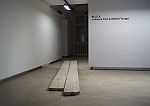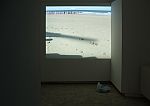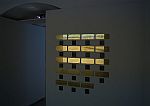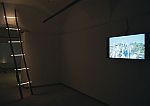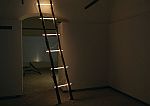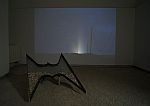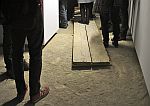The exhibition »BLOCK« by Johanna Tinzl and Stefan Flunger
Folder of the exhibition (download as pdf)
2022, a new European order /
Robot guards patrolling the border /
Cybernetic dogs are getting closer and closer /
Armored cars and immigration officers /
A burning village in Kosovo /
You bombed it out, now you're telling us go home /
Machine guns strut on the cliffs of Dover /
Heads down, people look out, we're going over /
Two images that not only resemble but contradict each other: here is the cone of a lighthouse, rhythmically scanning the night sky with its light – there is a radar casting repeated stripes of shadow on a sandy beach at noon; here historical architecture that helps travellers to find orientation at night – there technology made to keep travellers under surveillance; here is Calais in France – there Dover in Britain; here Tangiers in Morocco – there Tarifa in Spain; here Europe – there: not Europe.
Johanna Tinzl and Stefan Flunger employ the exhibition »BLOCK« to move literally and metaphorically along the European Union's external borders. In places where the purpose of high fences, barricades and military patrols is to prevent immigrants from non-European states from crossing Europe's topographical and/or political borders and fleeing from here to there, the artist couple educe structural similarities between the places they have visited and present them in the exhibition space as the visual essence of their journeys. In this context, they see the theme of »translation« not only in the linguistic sense but above all as a spatial and formal-aesthetic principle by which to create multilayered situational transfers: trans-l(oc)ating from here to there.
Burnin' up, can we survive re-entry /
Past the mines and the cybernetic sentries /
Safe European homes built on wars /
You don't like the effect, don't produce the cause /
The chip is in your head, not on my shoulder /
Total control just around the corner /
Keep banging on the wall of Fortress Europe /
The video installation »Tarifa-Calais« (2011) is arranged along the north-south axis of the exhibition rooms and provides the framework to the exposition with its ominous title »BLOCK«. This work is projected as a block on two opposite facing walls and in it Johanna Tinzl and Stefan Flunger recreate the lack of compromise – using short video loops of surveillance architecture at the southern and northern borders of Europe – characteristic of this politically motivated construct's supervision over the past decade. The aim of the lighthouse on the border from Tangiers to Tarifa is to track down migrants from the Maghreb and Africa and prevent them from heading across the continent via southern Spain – the radar at the Calais-Dover border reveals refugees from the former British colonies attempting to find a way into the colonists' country via France. But the two artists do not pinpoint the actual architecture in their criticism of the structures behind these increasingly manifest European control and defence mechanisms.
Instead, they use the contrasting play of light, shadow, visibility and invisibility to recreate the pictures produced by such instruments. By positioning the video images opposite each other within the exhibition room, they also compel visitors to follow the same route from south to north, i.e. from Tangiers/Tarifa to Calais/Dover, so making their way along part of the route on which the migrants embark.
We got a right, know the situation /
We're the children of globalization /
No borders, only true connection /
Light the fuse of the insurrection /
This generation has no nation /
Grass roots pressure the only solution /
We're sitting tight /
Cause asylum is a right /
On the floor between the two videos of »Tarifa-Calais« and scattered throughout the exhibition rooms there is a fine sand, which refers to the fringe between water and solid ground along the topographical borders of the European Union. As well as the formal equation of the video images through their presentation as endless loops, Johanna Tinzl and Stefan Flunger succeed in connecting two places with their installation-based intervention into the spatial structures, and also in capturing the transfer – the translation from south to north – in vividly comprehensible images. On the floor directly in front of the two videos there are two objects; these refer to each other and so connect the two rooms: here we see a plastic sack in which the artist couple brought back stones to Austria from the beaches of Albania after one of their trips. The border between the west coast of Albania and the east and south coast of Italy only a few kilometres away was particularly explosive during the 1990s, but alongside Calais/Dover and Morocco/Spain it has always been another neuralgic point in the movements of European migration.
Opposite to the apparently casually placed plastic sack is an object entitled »Operative Risk« (2011). While the plastic sack is empty and conjures the artist couple's role as tourists or outsiders, the metal object contains the very stones that Johanna Tinzl and Stefan Flunger originally transported in the plastic sack. In turn, »Operative Risk« adopts the seemingly technoid form of a detail from what is known as NATO-wire. The hooks of this barbed wire, which is widely used as a bulwark to protect »Fortress Europe«, are taken out of their context, enlarged and presented as a moveable object in the exhibition space. As the stones rock from here to there, »Operative Risk« produces a noise indeed similar to the roar of the ocean, but equally artificial and threatening. »On solid ground, NATO-wire is used to top fences and walls,« Johanna Tinzl and Stefan Flunger comment on this work: »But if the sea is the border, even the water is turned into a razor.«
Burnin' up can we survive re-entry /
Past the land mines and cybernetic sentries /
Plane, train, car, ferry boat or bus /
The future is bleeding coming back at us /
The chip is in your head not on my shoulder /
Total control around the corner /
Open up the floodgates, time's nearly up /
Keep banging on the wall of Fortress Europe /
Johanna Tinzl and Stefan Flunger have placed the object »Storm« (2011) and the video »La valla es europeo. The Fence is European.« (2011) at the spatial as well as the conceptual centre of the exhibition »BLOCK«. Initially, a ladder blocks the visitor's path. The artist couple use this object to refer to a mass attempt by migrants to storm the fence between the Spanish enclave Melilla and Morocco with hand-made ladders in 2005; as one enters the space, it anticipates how the two artists transfer the methods of translation from an exclusively linguistic context into a spatial one. The artists respond to the Spanish word »clandestino« (secret), which is used to refer to illegal immigrants, by reconstructing and remodelling – using tree trunks and neon tubing – the ladders that the refugees made from wood and plastic.
The aspect of transposition and interpretation that is decisive in any translation process ultimately becomes evident in the video. »La valla es europeo. The Fence is European.« shows a taxi drive along the same fence between Morocco and Melilla that we have already found as a reference in the ladder upon entering the central exhibition space. The complexity and explosiveness of the political situation in North Africa is explained by the taxi driver during this journey: in simple words, permanently repeating himself and returning to the beginning. So that the non-Spanish-speaking passengers can also understand what he has to say, the chauffeur comments on the high barrier – which is erected in three rows and topped with NATO-wire – in this insistent manner throughout the entire trip. However, the viewers of the video don't hear the language of the man from Melilla but a German transcription, which is spoken onto the soundtrack by a taxi driver from Innsbruck. »In this video we are also anxious to break away from the use of purely documentary strategies in the sphere of art,« according to Johanna Tinzl and Stefan Flunger, who consciously avoided documenting up-to-date stories of individual immigrants and so reifying them for the purposes of their art. But the language of the taxi driver from the Spanish exclave is used in order to create a connection between the realities of life on the external borders of Europe and those in Central Europe. When the artist couple show this video in different places, the man from Melilla's text is translated into the language of the relevant country and repeated by a local taxi driver.
They got a right, listen not to the scaremonger /
Who doesn't run when they're feel the hunger /
From where to what to when to here to there /
People caught up in red tape nightmare /
Break out of the detention centers /
Cut the wires and tear up the vouchers /
People get ready it's time to wake up /
Tear down the walls of Fortress Europe /
In the installation »Azimuth« (2010/2011), Johanna Tinzl and Stefan Flunger adopt an approach similar to that of the video »La valla es europeo. The Fence is European.« Here, too, a conscious decision was made not to thematise individual destinies but to take up the stories of nameless people. The installation, which is positioned opposite one of the video works of »Tarifa-Calais« in the exhibition »BLOCK« and indeed mirrors it, comprises a series of brass and iron plaques. It was begun in the former cartographical institute in Vienna and is extended by several objects each year. Since 1993, the source of the research project has been data collected by the NGO »United«, based in Amsterdam, about people who lose their lives in an attempt to cross borders. The artist couple have scratched a selection of these thousands of nameless refugees' fates – people who died in connection with the militarisation of our borders, due to asylum laws, refugee camps, detention pending deportation or during deportation – into the plaques they have produced and have then added the so-called azimuth. This calculating tool customarily employed in cartography comprises the angle, measured clockwise, between geographical north and any direction on earth. Johanna Tinzl and Stefan Flunger have taken the local origins of these people as the starting point to their artwork and subsequently marked the directions in which the refugees set out. »The movement of migration is primarily from the south in a northerly direction – in this work that becomes quite obvious,« the artist couple state in connection with »Azimuth«: »In addition, it enables us to see how the history of European borders is changing. In 1994, for example, some people also died at the Austrian-Hungarian border – at that time the European Union was even smaller.«
Here is the direction in which people strive, the north – there is their starting point in the south; here we have border-crossing globalisation and networking capitalism – there we see NATO-wire and barricades; here is Europe – there: not Europe, and far more than two images both resembling and contradicting each other.
Dis is a 21st century Exodus /
Tear down the walls of Fortress Europe /
Dis is a 21st century Exodus /
We got the right! /
Keep banging /
Keep banging on the wall /
Of Fortress Europe /
Let's say it again! /
Text: Franz Thalmair, 2011
Translation: Lucinda Rennison
[All quotations taken from: Asian Dub Foundation, »Fortress Europe«, 2003]
